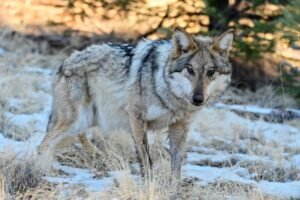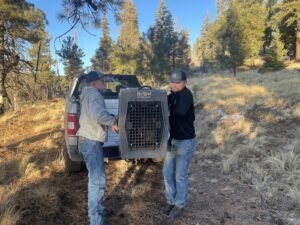
The wild Mexican gray wolf population has reached a new milestone with a minimum of 286 wolves now roaming the landscapes of New Mexico and Arizona, according to the latest annual census released by state wildlife agencies. This marks the ninth consecutive year of population growth for this endangered subspecies, representing an 11% increase from the 257 wolves counted in 2023.
The continued growth of this critical and singular wild lobo population is a testament to the species’ resiliency and their rightful place on landscapes where they have roamed for thousands of years. These native southwestern wolves are an essential part of our state’s natural heritage and ecological health.
The population is currently distributed with 162 wolves in New Mexico and 124 in Arizona, with a total of 60 packs documented at the end of 2024. The interagency field team also reported that 164 pups were born in 2024, with 79 surviving until year’s end—a 48% survival rate.
Fostering Program Shows Promise
One bright spot in the recovery effort has been the success of the wolf fostering program, where captive-born pups are placed in wild dens. To date, at least 20 fostered Mexican wolf pups have survived to breeding age, and at least 10 fostered wolves have successfully bred and produced litters in the wild. These fostered wolves have produced more than 20 litters, with some of their offspring now producing pups of their own—a critical step in addressing the genetic challenges facing the population.
Serious Challenges Remain
Despite this encouraging growth, the Mexican gray wolf recovery faces significant hurdles. Conservation groups point to four primary concerns threatening the population’s long-term viability:
- Genetic Crisis: The wild population continues to face a serious genetic bottleneck. The entire Mexican wolf recovery program stems from just seven founding wolves, making genetic diversity a critical issue that becomes more difficult to address as the population grows.
- Artificial Boundaries: Current management restricts wolves to areas south of Interstate 40, preventing them from dispersing into suitable habitats in the Grand Canyon ecoregion and Southern Rockies. Scientists have long recommended establishing three subpopulations of at least 200 wolves each (with a minimum of 750 total) spread throughout the southwestern United States to ensure true recovery.
- Potential Budget Cuts: Conservation advocates have expressed concern that the Trump administration may reduce funding for Mexican wolf recovery efforts, which could undermine progress made over the past decades.
- Threats to ESA Protections: There is growing concern that Congress may weaken the Endangered Species Act or take action to remove ESA protection from Mexican wolves before the species has truly recovered to the point where they no longer require the safeguards of the ESA to avoid the threat of extinction.
Several Mexican gray wolves have attempted to disperse naturally north of the I-40 boundary, demonstrating that these animals are capable of finding and potentially thriving in suitable habitat beyond this artificial limit. The Grand Canyon ecoregion and the southern Rockies offer the space, prey, and ecological connectivity necessary for true recovery.
The recent death of Ella, a Mexican gray wolf who had ventured north of Interstate 40 near Mount Taylor in March 2025, highlights the ongoing challenges faced by wolves attempting to naturally expand their range. Ella’s journey represents what many biologists see as a crucial step for true recovery of the species—the ability to disperse into historically occupied habitats beyond artificial boundaries. According to conservation groups, illegal killing continues to be the leading cause of death for Mexican gray wolves, with agencies offering a combined reward of more than $105,000 for information leading to convictions in such cases. As the population grows south of I-40, more wolves like Ella may attempt similar dispersals, making protection against illegal mortality increasingly important for the species’ long-term recovery.

Management Rule and Recovery Plan Fall Short of Scientific Recommendations
For years, scientists have recommended to the U.S. Fish and Wildlife Service that Mexican wolf recovery requires three interconnected subpopulations spread throughout suitable habitat in the Southwest. Unfortunately, current management falls far short of these science-based recommendations, severely limiting the area where Mexican wolves are allowed to roam to a portion of southeast Arizona and southwest New Mexico, south of Interstate 40.
Current management also fails to adequately address the genetic health of the species. The individual Mexican wolves in the wild are about as related to each other as siblings. Conservation groups have urged the U.S. Fish and Wildlife Service to introduce more captive wolves into the wild population, including family groups, because the captive population is less genetically inbred than the wild population. As the size of the wild population grows, it becomes harder to improve the overall genetic diversity of the wild population through the infusion of captive wolves. While the population growth is positive, without addressing the genetic diversity issues and expanding the wolves’ range, the long-term survival of the subspecies remains in jeopardy.
New Mexico Wild continues to advocate for the science-based management of Mexican gray wolves that allows for natural dispersal into suitable habitats and implements measures to address genetic diversity challenges. We support strong protections under the Endangered Species Act and adequate funding for recovery efforts to ensure that future generations will have the opportunity to witness these magnificent animals in their native southwestern landscapes.

Mexican wolf recovery partners include the Arizona Game and Fish Department, New Mexico Department of Game and Fish, U.S. Fish and Wildlife Service, U.S. Forest Service, USDA APHIS Wildlife Services, White Mountain Apache Tribe, Bureau of Land Management, National Park Service, and various conservation organizations.

